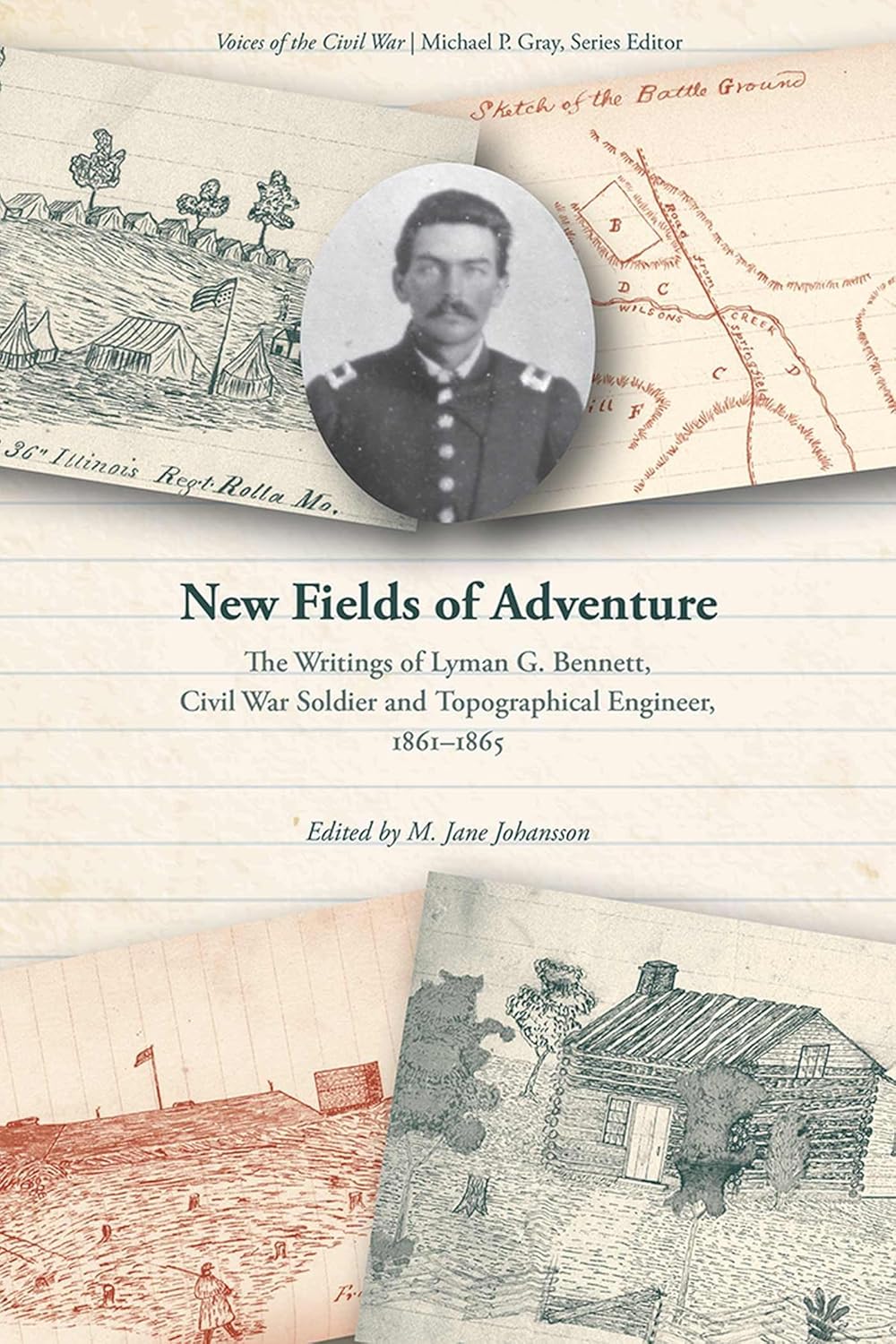Book Review: New Fields of Adventure: The Writings of Lyman G. Bennett, Civil War Soldier and Topographical Engineer, 1861-1865

 New Fields of Adventure: The Writings of Lyman G. Bennett, Civil War Soldier and Topographical Engineer, 1861-1865. Edited by M. Jane Johansson. Knoxville, TN: The University of Tennessee Press, 2024. Softcover, 399 pp. $39.95.
New Fields of Adventure: The Writings of Lyman G. Bennett, Civil War Soldier and Topographical Engineer, 1861-1865. Edited by M. Jane Johansson. Knoxville, TN: The University of Tennessee Press, 2024. Softcover, 399 pp. $39.95.
Reviewed by J. Gregory Acken
Lyman G. Bennett, the soldier whose experiences are chronicled in New Fields of Adventure, had been born in Connecticut, but the outbreak of the conflict found the married, 29-old father of one living in Illinois and working as a surveyor. Bennett tried unsuccessfully to join several of the early Illinois regiments raised in the immediate aftermath of the firing on Fort Sumter; he eventually enlisted in the 36th Illinois as a corporal in August 1861. Between then and the time he left government employ in 1866, Bennett had served in several capacities across the landscape of the American West, dutifully committing to paper, in colorful prose, much of what he saw.
Bennett’s expansive writings, which are composed principally of diary entries (supplemented by several contemporary letters and a post-war account), serve, as editor M. Jane Johansson aptly describes them, as a type of travelogue. After recording his impressions and observations, the sharp-eyed Illinoisan would send his diary pages home to his wife. Following two months serving in the 36th, Bennett’s surveying skills attracted the attention of higher-ups; pressed into service as a military engineer, he helped plan and construct Fort Wyman, protecting Rolla, Missouri. Later in the year, he performed the tasks of a topographical engineer, surveying much of the terrain around the town.
Following time spent in St. Louis preparing maps developed from his field endeavors, Bennett rejoined the 36th Illinois in time to participate with it in the March 7-8, 1862 battle of Pea Ridge. Bennett relates a finely detailed account of his combat experiences during the battle in northwest Arkansas, where his regiment played a key role in the critical action at Oberson’s Field. Several days after the fighting his engineering and surveying experience helped him secure a spot on the staff of Brig. Gen. Samuel R. Curtis, the victor at Pea Ridge, as a topographical engineer.
During the summer and fall of 1863, Bennett, having received a commission in the 4th Arkansas Cavalry, began the laborious process of trying to attract recruits. Though written sometime in the post-war period, Bennett’s account of his travails in the Ozarks, where he saw little to like in the towns and settlements he passed through, cajoling men (who he somewhat derisively referred to as “Mountain Feds”) to join the regiment, all the while fighting guerillas and bushwhackers, is both humorous and entertaining. Bennett was slightly wounded while serving with the 4th Arkansas and was eventually promoted to major. However, citing the “discontent existing in the regiment and the prejudice against northern officers,” Bennett resigned his commission in August 1864.
Not content to remain idle, Bennett became a civilian employee of the Engineer Corps in January 1865 and in that capacity surveyed several of the battlefields that featured in Confederate Gen. Sterling Price’s Missouri Raid. His work was polished enough that several of his maps are included in the atlas that accompanies the Official Records. Bennett then embarked on an adventurous 2,000-mile journey, covering several months that took him through Kansas and present-day Nebraska, Colorado, and Wyoming. During his trip, which, like all of his adventures, he recounts in great detail the surveyed lands and inspected fortifications.
Following the surrender of Confederate forces, Bennett, as a civilian engineering officer, took part in the July to October 1865 Powder River expedition against Native American tribes that had been attacking settlers; his experiences during that sojourn have already been brought to print, so his writings terminate on April 15, 1865.
Historian M. Jane Johannson, the editor of this fine collection letters, has done an exemplary job in preparing them for publication. Extensive chapter introductions lay the groundwork for Bennett’s prose and clear up any inconsistencies he might have recorded. End notes are plentiful, informative, and expertly written. It is clear, based on the sources cited and the commentary she provides, that Johannsen immersed herself in her subject, and the finished product is a delight to read.
Given the paucity of first-hand accounts by soldiers who served in Trans-Mississippi theater, this volume represents an important contribution to the small, but growing body of literature that has been produced about the far western reaches of the Civil War. The fact that it was written by a soldier who spent much of his service as an engineer enhances its uniqueness and value.
J. Gregory Acken is the editor of four books of Civil War history focusing on the experiences of Union officers. His most recent work, Through Blood and Fire: The Civil War Letters of Major Charles J. Mills, 1862-1865 (Kent State University Press, 2023) won a Distinguished Writing Award from the Army Historical Foundation.
I liked this review, book, and topic. It is a treat to have something special from the Trans-Mississippi theater.